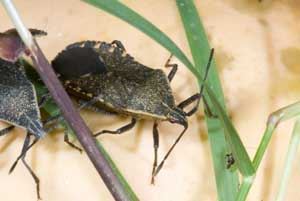Clean Up Those Fields With Fall Sanitation
DR. RIC BESSIN
LEXINGTON, KY.
With the first frosts of fall approaching and production for many vegetable fields exhausted, producers should be preparing fields for winter. Part of that preparation should be destruction of any crop residue remaining. Crop residue that remains in the field after harvest provides food for many of the insect pests we have been combating during the summer.

Figure 1. Squash bugs need to reach adulthoodto pass the winter.
Photo: Ric Bessin, UK
Sanitation of crop residue can be a helpful tactic to interrupt the lifecycle of pests. Most insect pests need to reach a specific stage in preparation for winter; sanitation reduces or eliminates their food, which interferes with their process of getting to these stages. Methods to eliminate crop residue include shredding, disking, and composting. Examples of insect pests that can be reduced through sanitation include squash vine borer, squash bug (Figure 1), stink bugs, Colorado potato beetle, corn earworm, and squash beetle. Producers that have planted Bt sweet corn are required to destroy crop residues within 30 days of the end of harvest. Timely sanitation can be a very effective pest management tool. ∆
DR. RIC BESSIN: Extension Entomologist, University of Kentucky